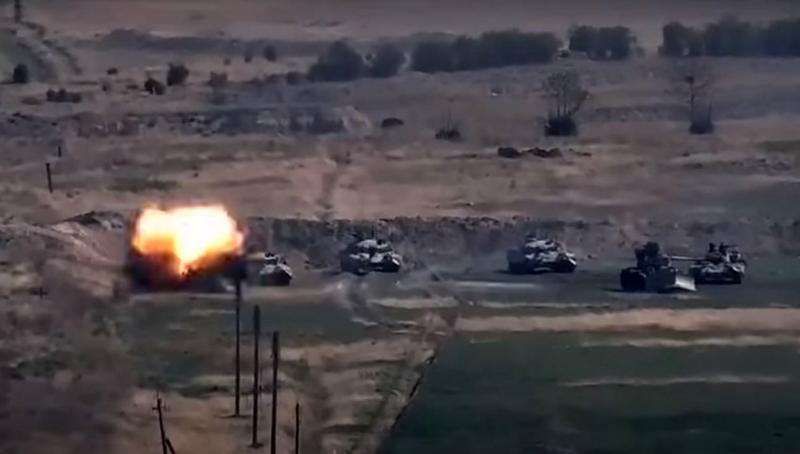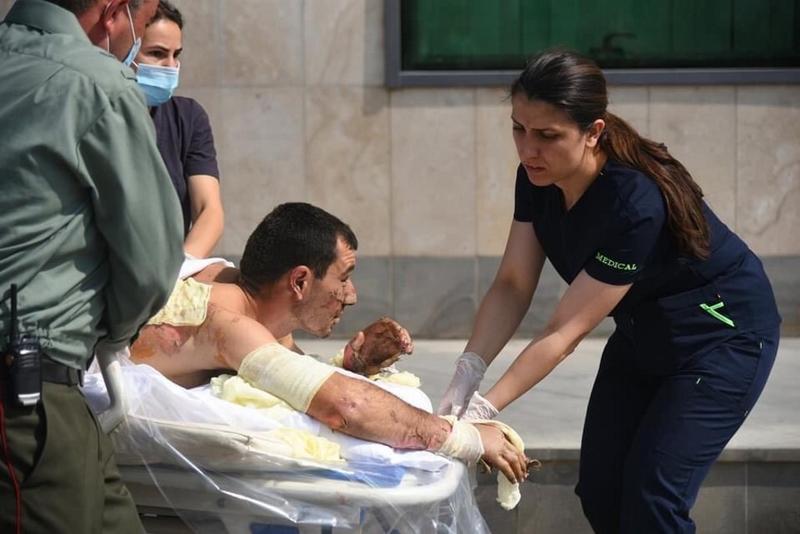 An image grab taken from a video made available on the official web site of the Armenian Defence Ministry on September 27, 2020, allegedly shows destroying of Azeri military vehicles during clashes between Armenian separatists and Azerbaijan in the breakaway region of Nagorno-Karabakh.( HANDOUT / ARMENIAN DEFENSE MINISTRY / AFP)
An image grab taken from a video made available on the official web site of the Armenian Defence Ministry on September 27, 2020, allegedly shows destroying of Azeri military vehicles during clashes between Armenian separatists and Azerbaijan in the breakaway region of Nagorno-Karabakh.( HANDOUT / ARMENIAN DEFENSE MINISTRY / AFP)
YEREVAN/BAKU - Fighting between Armenia and Azerbaijan escalated sharply on Monday in and around the mountain territory of Nagorno-Karabakh and at least 30 people were killed in a second day of heavy clashes.
Forces of the two ex-Soviet neighbours pounded each other with rockets and artillery in the fiercest explosion of the decades-old conflict in more than a quarter of a century.
Forces of the two ex-Soviet neighbours pounded each other with rockets and artillery in the fiercest explosion of the decades-old conflict in more than a quarter of a century
Any move to all-out war could drag in major regional powers Russia and Turkey. Moscow has a defence alliance with Armenia, while Ankara backs its ethnic Turkic kin in Azerbaijan.
“We haven’t seen anything like this since the ceasefire to the war in the 1990s. The fighting is taking place along all sections of the front line,” said Olesya Vartanyan, senior analyst for the South Caucasus region at Crisis Group.
She said increased deployment of rockets and artillery brought a higher risk of civilian casualties that could make the escalation hard to stop by diplomatic means.
ALSO READ: Clashes erupt between Azeris, Armenians over disputed land
“If there are mass casualties it will be extremely difficult to contain this fighting and we will definitely see a full-fledged war that will have a potential intervention of Turkey or Russia, or both of them,” Vartanyan said.
Majority Christian Armenia and mainly Muslim Azerbaijan first clashed in the 1980s over Nagorno-Karabakh, a breakaway region that is inside Azerbaijan but mostly populated and run by ethnic Armenians.
 This handout picture provided by the Armenian Foreign Ministry on September 28, 2020 shows medics helping a man, who is said was injured in clashes in Azerbaijan's breakaway region of Nagorny Karabakh. (HANDOUT / ARMENIAN FOREIGN MINISTRY / AFP)
This handout picture provided by the Armenian Foreign Ministry on September 28, 2020 shows medics helping a man, who is said was injured in clashes in Azerbaijan's breakaway region of Nagorny Karabakh. (HANDOUT / ARMENIAN FOREIGN MINISTRY / AFP)
The fighting has revived concern over stability in the South Caucasus, a corridor for pipelines carrying oil and gas to world markets.
Angela Frangyan, a film maker living in the Nagorno-Karabakh capital Stepanakert, said residents had taken cover in bomb shelters and constant shelling could be heard. All shops were closed and hardly anyone was in the streets, she said.
ERDOGAN DEMAND
Turkey’s President Tayyip Erdogan demanded Armenia immediately quit Azeri lands he said it was occupying and said it was time to end the Nagorno-Karabakh crisis.
Armenia’s parliament condemned what it said was a “full-scale military attack” by Azerbaijan on Nagorno-Karabakh. It said Azerbaijan was receiving Turkey’s help, and Ankara’s involvement could risk destabilising the region. Azerbaijan denied Turkey was taking part in the fighting.
Authorities in Nagorno-Karabakh said that 28 of its soldiers had been killed in fighting with Azeri forces on Monday, after saying on Sunday 16 of its servicemen had been killed and over 100 wounded when Azerbaijan attacked.
READ MORE: Death toll rises in Azerbaijan-Armenia border clashes
Nagorno-Karabakh also said it had recovered some territory that it had lost control of on Sunday. An Armenian defence ministry representative said 200 Armenians were wounded, Interfax reported.
The general prosecutor’s office in Azerbaijan said two Azeri civilians were killed on Monday, after five civilians were killed on Sunday, and 30 civilians had been wounded.
Interfax news agency quoted the press secretary of Azerbaijan’s defence ministry, Anar Evyazov, as saying the Azeri military occupied several strategically important heights near the village of Talish in Karabakh.
“Missile, artillery and air strikes are being applied to the enemy’s positions, which forces the enemy to surrender the held positions,” he said, adding that several important strategic heights around Talish village had been taken.
FLURRY OF DIPLOMACY
Evyazov also said Lernik Babayan, commander of the Armenian military’s airborne assault battalion, had been killed near Talish. It was not immediately possible to verify the report.
The clashes have spurred a flurry of diplomacy.
China urged both sides to show restraint. Russia called for an immediate ceasefire and Turkey said it would support Azerbaijan.
 In this photo released by the Armenian Foreign Ministry on Sept 27, 2020, people gather in a bombshelter to protect against shelling in Stepanakert, the self-proclaimed Republic of Nagorno-Karabakh, Azerbaijan. Fighting has erupted anew between Armenia and Azerbaijan over the disputed separatist region of Nagorno-Karabakh. (EDGAR KAMALYAN/ARMENIAN FOREIGN MINISTRY VIA AP)
In this photo released by the Armenian Foreign Ministry on Sept 27, 2020, people gather in a bombshelter to protect against shelling in Stepanakert, the self-proclaimed Republic of Nagorno-Karabakh, Azerbaijan. Fighting has erupted anew between Armenia and Azerbaijan over the disputed separatist region of Nagorno-Karabakh. (EDGAR KAMALYAN/ARMENIAN FOREIGN MINISTRY VIA AP)
The European Union and the Organization for Security and Cooperation in Europe (OSCE) urged both sides to stop military actions and return to negotiations, as did Pope Francis.
Under international law, Nagorno-Karabakh is recognised as part of Azerbaijan. But the ethnic Armenians who make up the vast majority of the population reject Azeri rule.
They have run their own affairs, with support from Armenia, since Nagorno-Karabakh broke away from Azerbaijan in a conflict that erupted as the Soviet Union collapsed in 1991.
Although a ceasefire was agreed in 1994, Azerbaijan and Armenia frequently accuse each other of attacks around Nagorno-Karabakh and along the separate Azeri-Armenian frontier.
At least 200 people were killed in a flare-up of the conflict between Armenia and Azerbaijan in April 2016. At least 16 people were killed in clashes in July.


